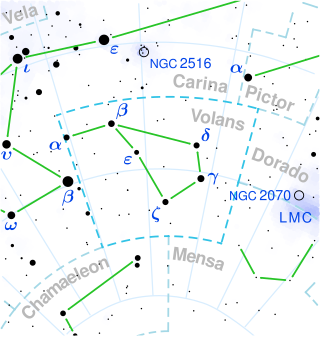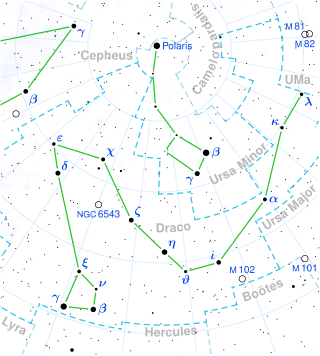
Atlas, designation 27 Tauri, is a triple star system in the constellation of Taurus. It is a member of the Pleiades, an open star cluster (M45). It is 431 light-years away, and is 3.92 degrees north of the ecliptic.
Xi Serpentis, Latinized from ξ Serpentis, is a triple star system in the Serpens Cauda (tail) section of the equatorial constellation Serpens. Based upon an annual parallax shift of 30.98 mas as seen from Earth, it is located 105.3 light years from the Sun. The star system is visible to the naked eye with a base apparent visual magnitude of +3.54. It is moving closer to the Sun and will make perihelion passage at a distance of 27 ly (8.2 pc) in around 690,000 years.
Pi Serpentis, Latinized from π Serpentis, is a solitary white-hued star in the constellation Serpens, located in its head, Serpens Caput. Based upon an annual parallax shift of 18.22 mas as seen from Earth, it is located around 179 light years from the Sun. It is visible to the naked eye with an apparent visual magnitude of 4.82.
Upsilon Serpentis, Latinized from υ Serpentis, is a star in the Serpens Caput section of the constellation Serpens. Based upon an annual parallax shift of 13.04 mas as seen from Earth, it is located around 250 light years from the Sun. The star is bright enough to be faintly visible to the naked eye, having an apparent visual magnitude of +5.70. It is a member of the Hyades group, a stream of stars that share a similar trajectory to the Hyades cluster.
Psi Serpentis is a triple star system within the Serpens Caput part of the equatorial constellation Serpens. Based upon an annual parallax shift of 68.22 mas as seen from Earth, it is located approximately 47.8 light years from the Sun. This system came closest approach to the Sun about 585,000 years ago when it made perihelion passage at an estimated distance of 23.27 ly (7.134 pc). Psi Serpentis is faintly visible to the naked eye with an apparent visual magnitude of 5.84.

Psi Virginis is a suspected binary star system in the zodiac constellation of Virgo. It can be seen with the naked eye and has an apparent visual magnitude of about 4.8. Based upon the annual parallax shift of 5.99 milliarcseconds, the distance to this star is roughly 540 light years. The angular size of Psi Virginis was measured on December 26, 1975 during an occultation by the Moon, yielding the estimate 6.5±0.3 mas.

Alpha Volantis, Latinized from α Volantis, is a binary star system located in the southern constellation Volans. It has an apparent visual magnitude of +4.00, which is bright enough to be seen with the naked eye. Based upon parallax measurements made with the Hipparcos spacecraft, it is located at a distance of 125 light years from the Sun. As of 2010, the two components of this system had an angular separation of 0.0318″ along a position angle of 286.9°. The magnitude difference between the two components is 0.1. It is considered a member of the Sirius supercluster.

2 Andromedae, abbreviated 2 And, is a binary star system in the northern constellation of Andromeda. 2 Andromedae is the Flamsteed designation. It is a faint star system but visible to the naked eye with a combined apparent visual magnitude of 5.09. Based upon an annual parallax shift of 7.7 mas, it is located 420 light years away. The binary nature of the star was discovered by American astronomer Sherburne Wesley Burnham at Lick Observatory in 1889. The pair orbit each other over a period of 74 years with a high eccentricity of 0.8.
26 Aurigae is a binary star system in the northern constellation of Auriga. It is visible to the naked eye as a faint star with an apparent visual magnitude of 5.41.

44 Boötis or i Boötis is a triple star system in the constellation Boötes. It is approximately 41.6 light years from Earth.
24 Cancri is a triple star system in the constellation Cancer. The system is located about 226 light-years away, based on its parallax. The system has a combined apparent magnitude of 6.5, and the two components A and B are separated by 5.7″.

Lambda Cassiopeiae, Latinized from λ Cassiopeiae, is a binary star system, in the northern constellation of Cassiopeia. The system has a combined apparent magnitude of +4.74, making it faintly visible to the naked eye. With an annual parallax shift of 8.64 mass, it is approximately 380 light years from Earth. The system is moving closer to the Sun with a radial velocity of −12 km/s.
HD 87822 is a triple star in the northern constellation of Leo Minor. The inner pair orbit each other with a period of about 18 years.
ψ Cygni, Latinised as Psi Cygni, is a triple star system in the constellation called Cygnus. With a combined apparent visual magnitude of 4.92, it is visible to the naked eye. As of 2002, the inner pair, components Aa and Ab, had an angular separation of 0.10 arc seconds along a position angle of 77.6°. Their combined visual magnitude is 5.05. Relative to this pair, the third member of the system, magnitude 7.61 component B, had an angular separation of 2.87 arc seconds along a position angle of 175.6° as of 2010. Based upon an annual parallax shift of 11.59 mas, Psi Cygni is located around 281 light years from the Sun.

Theta Draconis, a name Latinized from θ Draconis, is a binary star system in the northern circumpolar constellation of Draco. It is faintly visible to the naked eye at night with an apparent visual magnitude of 4.12. Parallax measurements place it at an estimated distance of 68.6 light-years from the Sun, and it is drifting closer with a radial velocity of −8 km/s. It has a relatively high proper motion, traversing the celestial sphere at the rate of 0.464″ per year. O. J. Eggen included this star as a member of the NGC 1901 supercluster based on its space motion.
Zeta Eridani is a binary star in the constellation of Eridanus. With an apparent visual magnitude of 4.80, it is visible to the naked eye on a clear dark night. Based on parallax measurements taken during the Hipparcos mission, it is approximately 110 light-years from the Sun.

Sigma Herculis, Latinized from σ Her, is a binary star system in the northern constellation of Hercules. It has a combined apparent visual magnitude of 4.18, making it bright enough to be visible to the naked eye. Based upon an annual parallax shift of 10.36 mas as seen from Earth, Sigma Herculis is located about 310 light years away from the Sun.
78 Ursae Majoris is a binary star system in the northern circumpolar constellation of Ursa Major. It is visible to the naked eye as a faint point of light with a combined apparent visual magnitude of 4.93. Parallax estimates by Hipparcos put it at a distance of 83 light-years (25 pc), but it is drifting closer with a radial velocity of −5 km/s. The system is a candidate member of the Ursa Major Moving Group.

25 Serpentis is a star system in the constellation of Serpens Caput. With an apparent magnitude of 5.37, it is just barely visible to the naked eye. The system is estimated to be some 450 light-years based on its parallax.
16 Serpentis is a binary star system in the Serpens Caput portion of the equatorial constellation of Serpens, located 228 light years from the Sun. It is visible to the naked eye as a fain, orange-hued star with an apparent visual magnitude of 5.261. The system is moving further from the Earth with a heliocentric radial velocity of +3 km/s.









